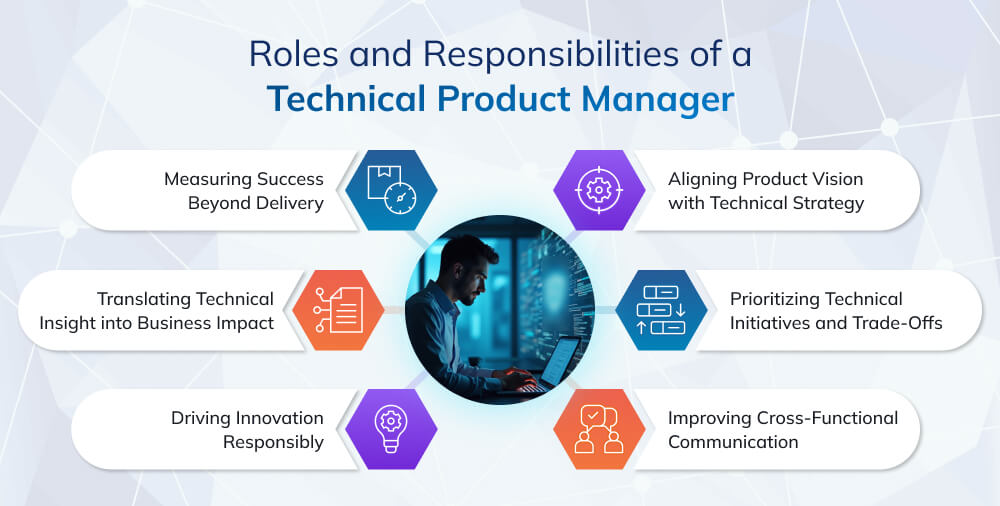
A few years ago, product managers were mostly customer advocates and project coordinators. Their job was to gather requirements, prioritize features, and hand over execution to engineering. Technical details? That was engineering’s world.
But in 2026, that separation of roles no longer works, and it can’t.
Every business works with tech now, from AI-powered fintech apps to cloud-driven supply chain platforms. Success depends not just on what is built, but how it’s built.
Modern product managers are expected to understand APIs, data systems, and architectural trade-offs, not code them, but to make smarter strategic decisions. According to a survey, AI quickly became a must-have for businesses. It prompts many organizations to adopt it out of fear of being left behind.
However, product managers began taking a more measured, strategic approach. Many companies now prefer product managers with technical fluency. The shift is clear from asking “what do users need?” to leading with “how do we deliver that through technology, at scale?”
In this article, we will discuss the technical product manager role and its responsibilities in detail.
Who Is a Technical Product Manager? Why Companies Need a TPM in 2026
Unlike traditional PMs who focus primarily on market needs and user experience, TPMs also dive into how things get built, understanding system architecture, data flows, and engineering constraints that shape product success.
In 2026, as products grow more complex with AI, automation, and cloud ecosystems, companies need professionals who can bridge the gap between vision and execution. That’s where a Technical Product Manager (TPM) becomes important.
1. To Align Technology with Business Goals
A TPM ensures every technical decision from system design to feature rollout directly supports business outcomes like scalability, performance, and ROI. They make sure engineering effort always maps back to strategy.
2. To Manage Complex Tech Stacks
With products now built on AI models, microservices, and APIs, companies need TPMs who can understand technical dependencies and guide teams through architectural trade-offs without slowing delivery. Hence, technical fluency with AI tools, stacks, and data analysis has become a baseline requirement for product managers.
3. To Improve Cross-Functional Communication
TPMs act as translators between engineering, design, and leadership, turning technical updates into clear business insights and preventing costly misunderstandings or project drift. For example, when a team proposes shifting to a new framework, a TPM explains how it impacts release timelines, customer experience, and revenue forecasts, ensuring all stakeholders make a good decision.
4. To Drive Innovation Responsibly
As companies integrate AI and emerging tech, TPMs ensure these innovations are deployed securely, ethically, and in compliance with regulations, balancing speed with accountability. For instance, when a fintech firm rolls out an AI-based credit scoring tool, a TPM oversees data privacy compliance, fairness testing, and security integration before launch, turning innovation into trust.
6 Core Roles and Responsibilities of a Technical Product Manager
The Technical Product Manager’s role sits at the intersection of strategy, technology, and execution. Their responsibilities go beyond defining features; they ensure that every decision supports both business goals and technical feasibility. Here are the core areas where TPMs make the biggest impact:
1. Aligning Product Vision with Technical Strategy
A Technical Product Manager ensures the product’s “why” is consistently reflected in how it’s built. In 2026, where technology architectures evolve faster than product roadmaps, TPMs act as the architects of continuity. They translate business priorities into scalable technical blueprints, ensuring decisions around frameworks, APIs, and infrastructure directly reinforce the product’s value proposition.
This alignment also means anticipating future trade-offs. TPMs assess their long-term implications on cost, maintenance, and performance. They make sure innovation doesn’t outpace stability, and that technical design choices remain consistent with where the product and the company are headed.
To achieve this, TPMs:
|
2. Prioritizing Technical Initiatives and Trade-Offs
Product success depends as much on what not to build as on what gets built. Technical Product Managers play a critical role in prioritizing initiatives that balance innovation with delivery speed and technical sustainability. They ensure engineering efforts are directed toward features and architectures that create measurable business impact.
TPMs constantly evaluate trade-offs between short-term gains and long-term scalability. Whether deciding between refactoring legacy code or launching a new AI-driven module, they make data-backed choices that optimize both performance and value creation.
To drive these decisions, TPMs:
- Use cost-benefit frameworks (like RICE or WSJF) to rank initiatives based on business impact, technical complexity, and risk.
- Collaborate with finance and engineering leads to forecast resource utilization and ROI of technical investments.
- Identify technical debt early and prioritize remediation before it affects reliability or delivery velocity.
- Set up measurable trade-off criteria so teams can make consistent decisions under time or resource pressure.
3. Improving Cross-Functional Communication
Technical Product Managers are the ones making sure those tools actually talk to each other and to the people behind them. Instead of juggling scattered spreadsheets or endless Slack threads, TPMs rely on effective lean management tools and connected platforms like Jira, Productboard, Notion, and Linear to bring teams onto the same page. They link these with GitHub or Jenkins for engineering updates and Power BI or Tableau for business metrics, creating a single place where everyone can see what’s happening and why.
Here’s how they make that work day to day:
| Goal | Tool Use | Result |
| Keep strategy and execution in sync | Map goals in Productboard or Notion directly to Jira tickets | Everyone knows how work connects to the bigger picture |
| Cut down on status meetings | Auto-sync Jira with analytics dashboards for instant reports | Leadership gets live updates without chasing them |
| Avoid roadblocks | Connect Linear and GitHub to flag blockers early | Teams fix issues before they turn into delays |
| Stay ahead of risks | Use AI tools for delivery forecasts and dependency mapping | Projects run smoother, with fewer last-minute surprises |
4. Driving Innovation Responsibly
Did you know? More than 4/5th of consumers are willing to pay more for sustainability, even as cost-of-living pressures weigh. Technical Product Managers play a key role in helping companies innovate with intention. They understand that adopting AI, automation, or blockchain isn’t just a technical decision; it’s a strategic one that touches ethics, security, and compliance.
A TPM looks at innovation through a long-term lens. When engineering proposes a new AI recommendation engine or data pipeline, they don’t just ask “Can we build this?” — they ask “Should we build this, and what are the risks?” They evaluate performance trade-offs, regulatory implications, and how new features align with the company’s core value proposition.
They also design frameworks for responsible innovation, setting up guardrails for data handling, validating model outputs for fairness, and working closely with compliance teams to keep pace with changing global standards.
| Key Insight:
Technical Product Managers are redefining innovation by combining curiosity with caution. In an era where every company wants to be “AI-powered,” TPMs ensure that progress isn’t just fast, it’s responsible, compliant, and genuinely valuable to both the business and the user. |
5. Translating Technical Insight into Business Impact
One of the most defining qualities of a Technical Product Manager today is their ability to turn complex technical realities into clear business outcomes. They understand what those things mean for growth, scalability, and customer value.
In 2026, as businesses lean more on data-driven decision-making, TPMs act as interpreters between engineering depth and executive priorities. They convert latency improvements into measurable cost savings, or system uptime into customer retention metrics that leadership can act on.
Their technical fluency also helps shape smarter investment decisions. TPMs can spot when a new feature requires architectural upgrades, when cloud spending can be optimized, or when automation will deliver the highest ROI. Beyond systems and code, they also evaluate the human element, identifying when teams need corporate training to adopt new technologies or refresher programs on project management fundamentals to improve delivery efficiency.
6. Measuring Success Beyond Delivery
For modern Technical Product Managers, success doesn’t stop at product launch; it’s measured in how well the product performs, scales, and supports business growth. In 2026, TPMs are expected to connect technical health with business outcomes, ensuring every engineering effort delivers lasting impact.
They move past traditional delivery metrics and focus on evidence-based performance. Instead of just asking “Was it delivered on time?”, they ask “Is it delivering value technically and commercially?” TPMs partner with data, DevOps, and customer success teams to track real-world results and identify what needs to evolve next.
Here are some KPIs TPMs often monitor in tech companies:
| Category | Key KPIs | Purpose |
| Technical Performance | System uptime (%), API latency, page load time, mean time to recovery (MTTR) | Measure reliability, speed, and resilience |
| Engineering Efficiency | Deployment frequency, change failure rate, code review turnaround time | Assess delivery speed and code quality |
| Product Adoption | Active users, feature usage rate, retention rate | Track real-world product engagement |
| Business Impact | Customer acquisition cost (CAC), customer lifetime value (CLV), revenue per feature | Link technical output to business growth |
| Operational Health | Infrastructure cost optimization, cloud resource utilization, and technical debt ratio | Ensure scalability and cost efficiency |
These metrics help TPMs see the full picture of how technical improvements drive financial performance and user satisfaction over time.
Top 6 Challenges and Practical Solutions for Technical Product Managers in 2026
Now that we’ve explored what Technical Product Managers actually do and why their role matters in 2026, it’s worth looking at the other side of the story, the challenges.
Because while TPMs drive innovation and clarity across teams, the job comes with its own share of tough trade-offs, constant learning curves, and coordination headaches.
| Challenge | What Makes It Tough | How TPMs Tackle It |
| Balancing innovation with technical debt | New ideas often take priority, leaving behind messy code and fragile systems. | TPMs build debt cleanup into roadmaps and use data to show why it’s worth the investment. |
| Getting tech and business on the same page | Engineers talk in systems, leadership talks in outcomes, and things get lost in between. | They use shared tools (like Jira and Product board) and translate updates into an impact everyone understands. |
| Keeping up with fast-moving tech | AI, cloud, and automation are evolving faster than most teams can adapt. | TPMs push for ongoing learning, arranging team training or certifications before scaling new tech. |
| Proving the ROI of technical work | It’s hard to show how “better architecture” translates to business value. | They connect metrics like uptime or speed to customer retention and revenue outcomes. |
| Staying compliant while innovating | Every new AI feature or data workflow comes with legal and ethical risks. | TPMs bake compliance reviews into the product cycle, not as an afterthought but a standard step. |
| Managing hybrid teams | When everyone’s spread across locations, communication and visibility get tricky. | TPMs rely on async updates, clear dashboards, and rituals that keep momentum without micromanaging. |
How to Prepare for a Technical Product Manager Role in 2026
If you’re aiming to become a Technical Product Manager, 2026 is shaping up to be one of the most dynamic times to enter the field. But unlike traditional PM roles, TPMs need to blend technical fluency with strategic thinking, and that doesn’t happen overnight.
Here are a few smart ways to prepare for the role (without just stacking certificates):
- Strengthen Your Technical Foundations
You don’t need to be an engineer, but you should understand how systems talk to each other. Learn the basics of APIs, databases, cloud architecture, and how modern software delivery works (Agile, CI/CD, DevOps). This helps you speak the same language as your engineering team.
- Learn to Think in Systems, Not Features
Great TPMs don’t just ask what to build, they ask how it fits into the bigger picture. Get comfortable mapping dependencies, understanding scalability, and recognizing how one change can ripple through the entire product ecosystem.
- Build Analytical and Decision-Making Skills
TPMs rely heavily on data. Sharpen your ability to analyze trends, define KPIs, and make trade-offs using frameworks like RICE or cost-benefit analysis. The goal is to tie technical work to measurable business outcomes.
- Invest in Management and Process Expertise
Pair your technical knowledge with structured management training. Programs like Lean Six Sigma, Agile Project Management, or ITIL give you the process mindset to lead complex teams efficiently. These aren’t just “extra badges,” they teach you how to think in terms of continuous improvement and quality delivery.
Spotify: Redefining How the World Listens to MusicWhen music piracy was at its peak and album sales were declining, Spotify faced a dual challenge: technological and cultural. The company had to reinvent how people accessed and paid for music while maintaining fairness for artists and producers. Role of the Technical Product Manager (TPM):
Solution:
Impact:
Key Learning: Source: digitaldefynd.com |
Conclusion
Landing a Technical Product Manager role and responsibilities in 2026 isn’t about collecting fancy titles; it’s about combining technical understanding with leadership, communication, and strategic vision. The best TPMs know how to balance code with customer value, and engineering logic with business goals.
If you’re serious about growing into this role, focus on real-world learning. Invensis Learning offers practical management courses from Agile to Six Sigma, designed to sharpen both your technical and business mindset.
Because in the end, being a great TPM is less about theory and more about how well you can turn complex ideas into successful products.
FAQs
1. How is a Technical Product Manager different from a regular Product Manager?
A Technical Product Manager (TPM) goes beyond defining what to build they understand how it’s built. Unlike traditional PMs, TPMs work closely with engineering teams, dive into APIs, system architecture, and technical trade-offs to make smarter, faster product decisions.
2. What skills should a Technical Product Manager have in 2026?
In 2026, TPMs need a mix of technical fluency and business acumen, understanding AI, data systems, and cloud platforms, while also mastering prioritisation, stakeholder management, and communication across departments.
3. Can someone transition into a Technical Product Manager role without an engineering background?
Yes, but it requires upskilling. Many successful TPMs come from product or business backgrounds and bridge the gap by learning about technology stacks, system design fundamentals, and tools like Jira, Confluence, or SQL.
4. What challenges do Technical Product Managers commonly face?
They often juggle competing priorities, balancing innovation with stability, managing communication gaps between business and tech teams, and ensuring new technologies align with long-term strategy rather than just chasing trends.
5. How can corporate training help in becoming a better Technical Product Manager?
Corporate training helps TPMs strengthen both technical and managerial muscles. Programs like Six Sigma, Agile, or Product Leadership courses (such as those by Invensis Learning) offer hands-on frameworks to align business goals with technical execution, turning theory into real-world results.
















